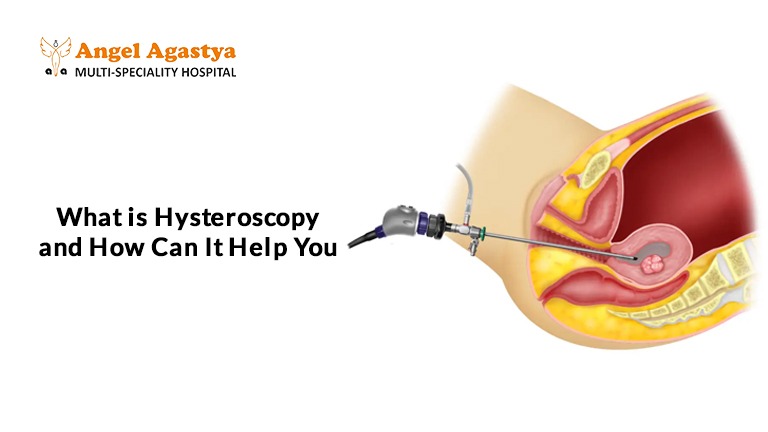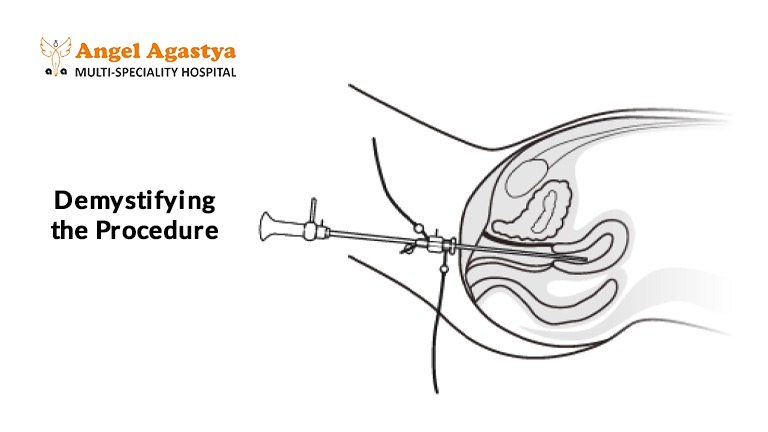What is Hysteroscopy and How Can It Help You? A Simple Guide.
Are you dealing with irregular periods, unexplained infertility, or repeated miscarriages? Hysteroscopy might be the answer you’re looking for. This safe and minimally invasive procedure helps doctors see inside the uterus and often treat problems in the same session. In this guide, we break down when and why it’s used, what to expect, and how it could help you feel more in control of your reproductive health.

Have you ever experienced the unsettling feeling of abnormal bleeding, the frustrating journey of infertility, or the anxiety of recurrent miscarriages? For many women, these health challenges can be a source of significant worry and disruption to their lives. Understanding the root cause of such issues is the first step towards finding effective solutions. In the realm of women’s health, a minimally invasive procedure called hysteroscopy offers a direct and often painless way to look inside the uterus, unlocking answers and paving the way for treatment for a range of common problems.
This blog explains what hysteroscopy is, why it’s recommended, the six common women’s health issues it can help diagnose or treat, and what to expect regarding symptoms, safety, cost, and recovery. By understanding this valuable diagnostic and beneficial tool, you can feel more informed and empowered when discussing your health with your doctor.
What Exactly Is Hysteroscopy?
At its core, hysteroscopy is a non-surgical procedure that allows a physician to visualize the inside of a woman’s uterus. This is achieved using a hysteroscope, a thin, telescope-like instrument equipped with a light and a camera. The hysteroscope is carefully inserted through the vagina and cervix, the natural opening to the uterus, eliminating the need for any incisions.

Once inside the uterus, the camera transmits real-time images of the uterine lining onto a monitor. It gives the doctor a close-up, detailed view of the uterine lining, enabling them to identify any abnormalities that might be present. The procedure can be purely diagnostic, helping to pinpoint the cause of certain symptoms, or it can be operative, allowing for the treatment of specific conditions at the same time. Being a gentle, low-risk procedure, hysteroscopy typically causes less pain, ensures faster recovery, and carries fewer risks than open surgeries.
Why and When Hysteroscopy Is Recommended: 6 Common Women’s Health Concerns
Hysteroscopy is a non-invasive alternative to surgery and treatment tool often used to evaluate and manage various gynecological concerns.It provides a clear view of the uterus, helping detect issues often missed by imaging or lab tests.. Here are six common situations where hysteroscopy can make a significant difference:

1. Abnormal Uterine Bleeding
If you’re experiencing periods that are unusually heavy, prolonged, or come too frequently or if you’re bleeding between periods your doctor may want to investigate further. Hysteroscopy helps identify the cause by providing a clear view of the uterine lining. Common findings include polyps (small growths), fibroids (benign tumors), or thickening of the endometrium. These conditions can disrupt your cycle and may even contribute to anemia due to blood loss. In many cases, they can be treated during the same procedure, avoiding the need for more invasive surgery.
2. Postmenopausal Bleeding
Bleeding after menopause is not considered normal and should never be ignored. Since the risk of uterine conditions including endometrial hyperplasia and cancer increases after menopause, hysteroscopy becomes a valuable diagnostic tool. It allows the doctor to examine the uterine cavity in detail and take tissue samples (biopsies) from any suspicious areas. Early detection through hysteroscopy ensures timely treatment and better health outcomes.
3. Infertility
For women struggling to conceive, a hysteroscopy can offer crucial insights. Sometimes, hidden structural problems within the uterus such as adhesions (scar tissue), a uterine septum (a wall dividing the cavity), or polyps may be interfering with embryo implantation. These issues often don’t show up clearly on imaging tests like ultrasound. Hysteroscopy not only helps diagnose these abnormalities but can also be used to correct them in the same session, increasing the chances of a successful pregnancy.
4. Recurrent Miscarriages
If you’ve had two or more consecutive miscarriages, your doctor may recommend a hysteroscopy to check if there’s a structural reason behind the losses. A septate uterus (a wall dividing the uterus) or scar tissue from previous surgeries or infections can prevent proper implantation or fetal development. Hysteroscopy can both detect and sometimes correct these issues, potentially reducing the risk of future pregnancy loss and improving reproductive outcomes.
5. Fibroids and Polyps
Fibroids (especially submucosal ones that grow into the uterine cavity) and polyps can cause abnormal bleeding, pelvic pain, and fertility issues. While larger fibroids may require other surgical methods, hysteroscopy is ideal for locating and removing smaller ones without external incisions. This minimally invasive approach provides quick relief from symptoms and often leads to a faster recovery.
6. IUD-Related Issues
An intrauterine device (IUD) is a common form of contraception, but occasionally, it may become displaced, embedded in the uterine wall, or its retrieval strings might not be visible. If this happens, hysteroscopy offers a safe and precise way to locate and remove the IUD without needing more extensive surgery. This is especially useful in avoiding complications and ensuring the uterus remains unharmed.
Preparing for a Hysteroscopy: What You Should Know

Understanding how to prepare for a hysteroscopy can ease anxiety and help you feel more confident going into the procedure. Here’s what to expect and how to get ready:
1. Timing the Procedure
Your doctor may schedule the hysteroscopy during the first half of your menstrual cycle (just after your period ends), when the uterine lining is thinnest and visibility is best. This timing helps ensure a more accurate examination and increases the chance of detecting small abnormalities.
2. Medications
You may be advised to stop certain medications, like blood thinners, and could be prescribed medication to soften the cervix for easier access. Always inform your doctor about all medicines and supplements you’re currently taking, including herbal remedies.
3. Fasting Instructions
If general anesthesia is planned, you may be asked not to eat or drink for a few hours before the procedure. Fasting helps prevent nausea or complications during anesthesia and ensures your safety.
4. Ask Questions
Don’t hesitate to ask your doctor what type of anesthesia will be used, how long the procedure will take, and what to expect afterward. Knowing what to expect can ease your anxiety and help you feel more in control.
5. Bring a Companion
It’s helpful to have someone accompany you, especially if sedation or anesthesia is involved, as you might feel drowsy afterward. A companion can help with transportation and emotional support after the procedure.
Demystifying the Procedure: Safety, Cost and Recovery
Understanding what to expect during and after a hysteroscopy can help alleviate anxiety and promote a smoother experience.

Safety: Hysteroscopy is generally considered a safe procedure with a low risk of complications. However, as with any medical procedure, some potential risks exist, although they are rare. These can include infection, bleeding, perforation of the uterus (a small tear in the uterine wall) and adverse reactions to anesthesia (if used). Your doctor will discuss these risks with you before the procedure.
Cost: The cost of a hysteroscopy can vary depending on several factors, including the location of the facility, the type of anesthesia used (local or general), whether it is a diagnostic or operative procedure and your insurance coverage. It is essential to discuss the estimated cost with your doctor’s office or the hospital billing department beforehand to understand your financial responsibilities. Insurance may cover part or all of the cost, especially if the procedure is deemed medically necessary.
Recovery: Recovery after a hysteroscopy is typically quick. Most women can return to their normal activities within a day or two. You may experience mild cramping similar to menstrual cramps and light vaginal bleeding or spotting for a few days. Your doctor may recommend over-the-counter pain relievers to manage any discomfort. It’s generally advised to avoid tampons, douching and sexual intercourse for a short period as instructed by your doctor to minimize the risk of infection. Your doctor will give you personalized aftercare instructions based on your condition.
Conclusion
Hysteroscopy stands as a valuable and gentle, low-risk procedure tool in the realm of women’s health. Its ability to directly visualize the uterine cavity allows for accurate diagnosis and often the effective treatment of a range of common issues, from abnormal bleeding and infertility to the removal of fibroids and polyps. By understanding the procedure, its benefits and what to expect in terms of safety, cost and recovery, women can approach this option with greater confidence and make informed decisions about their health. If you are experiencing persistent irregular periods or any of the other symptoms discussed, don’t hesitate to consult your healthcare provider to explore if hysteroscopy might be the right solution for you.
Experience Expert Gynecological Care at Angel Agastya Hospital
When considering your options for gynecological care and procedures like hysteroscopy, choosing a facility that prioritizes advanced treatments, compassionate staff and a healing environment is paramount. At Angel Agastya Hospital in Palam, Delhi, we are committed to providing world-class care to support your journey to better health.
Whether it’s a routine exam or a complex issue requiring intervention, including those that may necessitate hysteroscopy, our experienced team offers personalized care every step of the way. Our advanced gynecology services encompass a comprehensive range of treatments, including specialized care for infertility, non-surgical endoscopic procedures like hysteroscopy and safe surgical interventions when needed. We understand the sensitive nature of women’s health concerns and strive to create a comfortable and supportive environment where you feel heard and well-cared for. At Angel Agastya Hospital, your health and comfort are our top priorities.
Frequently Asked Questions about Hysteroscopy
1. What exactly is a hysteroscopy?
It’s a non-invasive alternative to surgery that uses a thin, lighted scope to examine the uterus.
2. Why might my doctor recommend a hysteroscopy?
List common reasons such as abnormal bleeding, infertility investigations, recurrent miscarriages, and suspected fibroids or polyps.
3. Is a hysteroscopy painful?
Explain that it’s generally well-tolerated, often described as mild cramping, and local anesthesia is often used. Mention that general anesthesia is an option in some cases.
4. How safe is hysteroscopy? Are there any risks?
Reassure readers that it’s generally a safe procedure with minimal risks, but briefly mention potential rare complications like infection or uterine perforation.
5. How much does a hysteroscopy typically cost?
Explain that the cost varies depending on location, facility, and insurance coverage, and advise readers to discuss costs with their provider.
6. What is recovery like after a hysteroscopy?
Describe the typical quick recovery, mentioning potential mild cramping and light bleeding, and the usual return to normal activities within a day or two.
7. Can hysteroscopy treat problems as well as diagnose them?
Yes, explain that in many cases, small polyps, fibroids, or adhesions can be removed during the procedure.
8. How do I prepare for a hysteroscopy?
Briefly mention that your doctor will provide specific instructions, which may include avoiding certain medications or scheduling the procedure at a specific time in your cycle.
9. How long does a hysteroscopy procedure usually take?
Provide a general timeframe, noting that it’s often a relatively quick outpatient procedure, typically lasting between 15 to 30 minutes.
10. Where can I get a hysteroscopy in Delhi ?
Directly mention Angel Agastya Hospital as a facility that offers this procedure, highlighting their advanced gynecology services and compassionate care.

